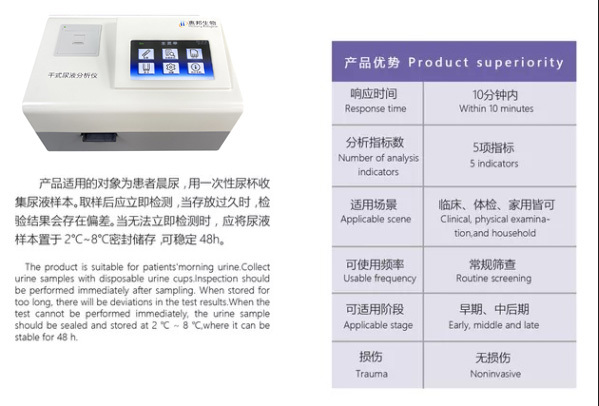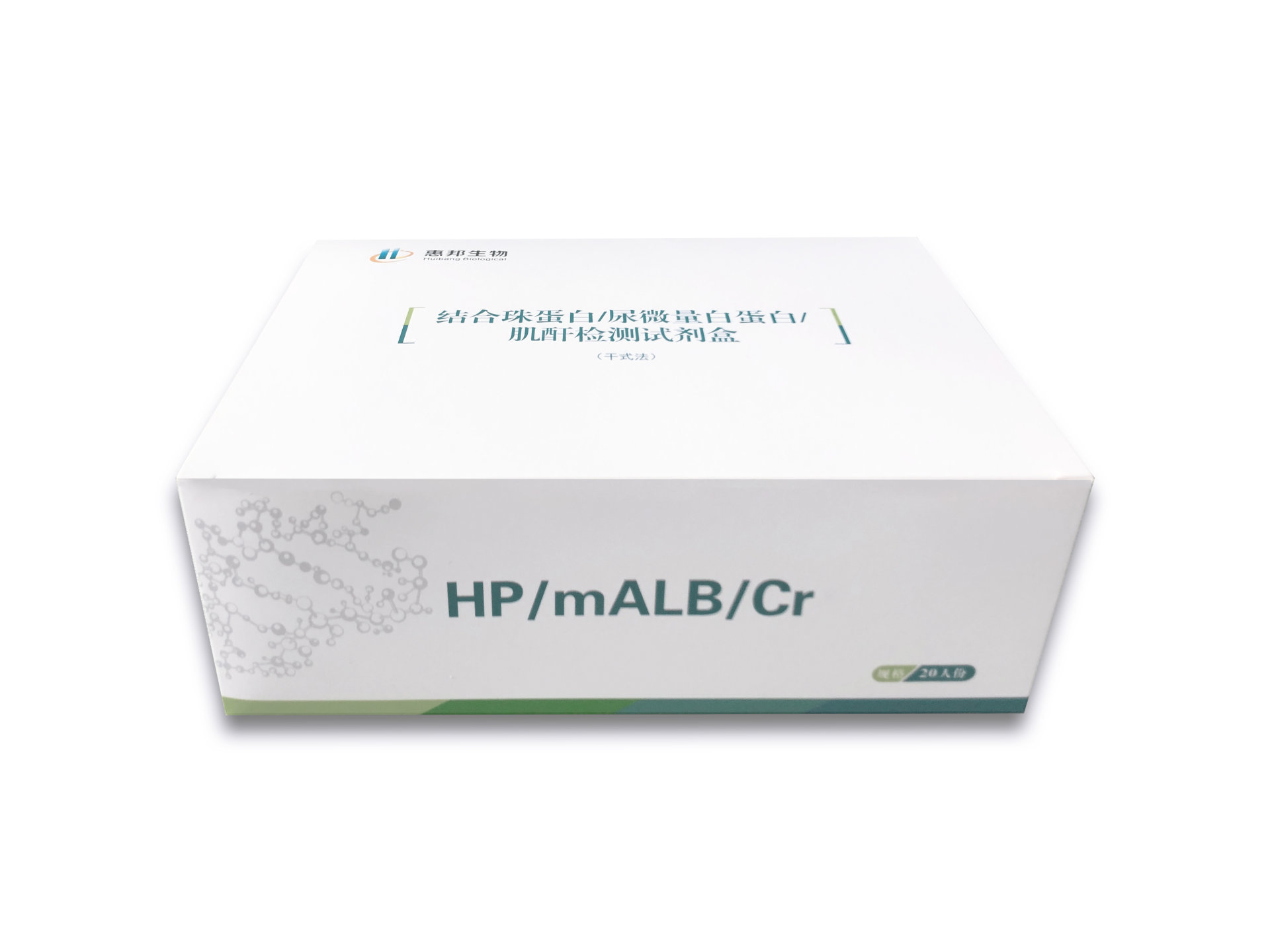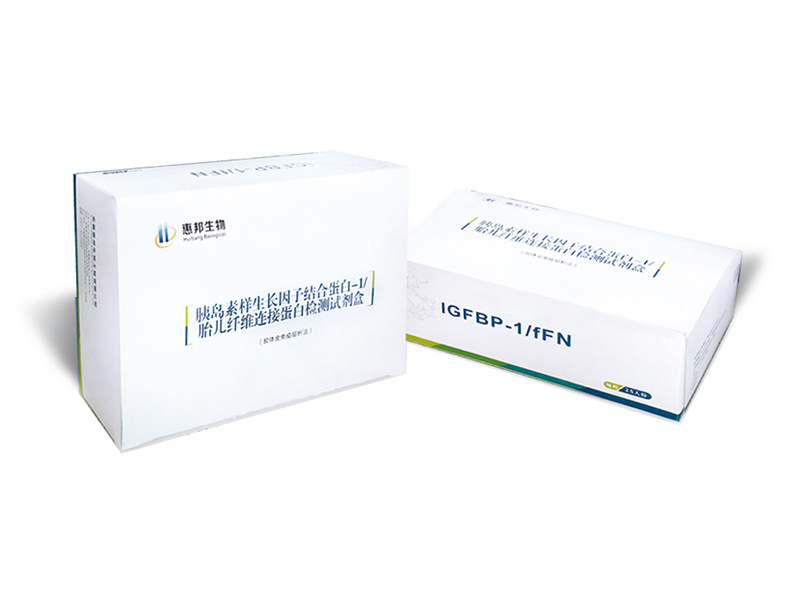Diabetic kidney disease non-invasive detection system
Classification:
Featured Items
Key words:
Tel:
Product Details
|
Product status |
International initiative, invention patent product(ZL 2017 1 0507989.9) |
|
Product status |
2021 China IVD Gold Award project, the sixth batch of suitable technology promotion projects in Anhui Province |
|
Product value |
In vitro detection of early diagnostic indicators of diabetic nephropathy in human urine |
|
Product Category |
Urine testing, second-class products, dry biochemistry + immunity |
|
Features |
Multi-channel composite detection, selected index combination, urinary microalbumin, urinary binding haptoglobin (exist in the blood of early diabetic patients, can occur before microalbumin, so the sensitivity is higher, and it is also the latest diabetic nephropathy Early diagnostic indicators), urine creatinine (as an internal standard, to standardize the detection value. Non-destructive test method, random urine self-test, dry reagent, superior than wet test, easy to carry, store and transport, and the stability of the property is longer than Wet reagents are relatively extended, and a series of testing products are developed according to different needs, and a two-level testing system is gradually formed. On the one hand, urine testing equipment is equipped in hospitals and physical examination centers to carry out precise quantitative testing; on the other hand, patients can perform self-testing at home. The test results can be uploaded by taking photos with mobile communication devices such as mobile phones, and the server will analyze and give feedback, and give professional suggestions or opinions in a timely manner. |
|
Core Technology |
For details, please refer to the introduction of "anti-human haptoglobin monoclonal antibody". |
|
Market demand |
The global incidence of diabetes is increasing year by year. my country is the largest country in the world with diabetes. In 2015, the number of patients was as high as 109.6 million, and 1.3 million people died of diabetes and its complications. Diabetic nephropathy is the main complication. The awareness rate of diabetes patients in my country is only 30%, and the proportion of people with diabetes is as high as 50%. The treatment rate and control rate of diabetes have dropped sharply with the delay of knowing the timely time. Early detection is imminent, but there is still no IVD product for early detection of diabetes in the market. |
|
Market capacity |
In theory, the future market demand for diabetic kidney injury detection: 280 yuan/person x 120 million people x 6 times = 200 billion yuan/year, and it is expected to be gradually developed in the next 5 years to detect more than 100 million people a year. |

1. Project background
According to the latest global diabetes map (IDF Diabetes Atlas) (version 9) released on the official website of the International Diabetes Federation (IDF)

In 2019, there were 463 million people with diabetes worldwide, and it will reach 578 million in 2030.
In 2019, diabetes patients in my country (20-79 years old) ranked first in the world, with 116.4 million people, and will reach 140.5 million in 2030
The key to the harm of diabetes is its complications. Diabetic kidney disease (DKD) is an important complication of diabetes and the main cause of chronic kidney disease and end-stage renal disease. Expert consensus believes that only early detection and early intervention can prevent problems before they happen .
The incidence of diabetic nephropathy is 40%, and its early diagnosis is urgent!
2. Detection system
Urinary microalbumin
Microalbuminuria (mALB):
Albumin is one of the important plasma proteins. Under normal circumstances, albumin has a large molecular weight and cannot cross the glomerular basement membrane. Therefore, the urine of healthy people only contains a very low concentration of albumin. During the disease, the glomerular basement membrane is damaged and the permeability changes. At this time, albumin can enter the urine, and the concentration of albumin in the urine will continue to rise, resulting in microalbuminuria.
Clinical significance:
Urinary microalbumin is one of the earliest indicators of glomerular microangiopathy
1. Early diagnosis of glomerular lesions, such as diabetic nephropathy, hypertension, lupus nephropathy, urinary system infection, heart failure, occult nephritis, etc.
2. To judge the severity of glomerular lesions.
Diabetic nephropathy causes glomerular damage. When the permeability of the glomerular filtration membrane increases, it will cause obvious proteinuria, and albumin appears in the urine. Urinary microalbumin is a sensitive and reliable indicator of diabetic kidney damage, which can reflect glomerular damage.
Urine creatinine
Urine creatinine (UCr):
90% of the creatine in the human body exists in the muscle, and most of it exists in the form of phosphocreatine. Creatine phosphate is dephosphorylated to produce creatinine, which is excreted in urine as creatinine.
Urine microalbumin to creatinine ratio (ACR): refers to the ratio of urinary microalbumin to creatinine ACR=MAlb/CRE
Urine albumin/creatinine ratio: it is a sensitive and reliable indicator for the diagnosis of early diabetic nephropathy. The detection of urinary microalbumin is the most sensitive and reliable diagnostic index for early detection of nephropathy. Through the value of urinary microalbumin, combined with the onset, symptoms and medical history statement, the disease can be diagnosed more accurately, and the stage of fibrosis can be judged. Urinary microalbumin/urinary creatinine is very meaningful in judging diabetic nephropathy.
Urinary microalbumin to creatinine ratio

A number of international medical institutions (NKF-KDOQI American Kidney Foundation, ASH American Society of Hypertension, ADA American Diabetes Association) issued guidelines on the clinical application of urine albumin detection, all of which advocate the determination of ACR; recommended for early Standards for kidney disease screening and diagnosis and staging of chronic kidney disease. Especially the first morning urine ACR has good stability and consistency with segment urine UAE, and it is convenient to take and can replace UAE. ACR is recommended by K/DOQI guidelines for screening MAlb in high-risk groups.
Urinary haptoglobin
Human urine Hp index can detect early diabetic nephropathy in human body, and can detect early diabetic retinopathy in human body at the same time. Increased urinary Hp concentration is related to acute kidney injury and active inflammatory response. In diabetic patients, increased urinary Hp concentration is a biomarker of early DKD and has the function of early prediction of kidney disease in diabetic patients.
The sensitivity and accuracy of urinary haptoglobin in predicting type II diabetic nephropathy have been recognized by authoritative experts.
In recent years, it has been found that it is related to DKD, which is also diabetic microangiopathy. Different from the mechanism of urinary microalbumin, studies have shown that haptoglobin in urine mainly comes from the secretion of kidney tissue itself or cell shedding, rather than blood, so it can detect DKD before glomerular permeability changes, earlier than urinary microalbumin. albumin.

3. Detection method
1. Kidney biopsy: It has the most value in differential diagnosis for various types of chronic kidney disease, but because of its high degree of invasiveness, routine testing is not recommended.
2. Urinary microalbuminuria/creatinine (ACR): the most widely used clinically, but because its level is affected by many factors, and long-term observation results show that only 30% to 45% of patients with microalbuminuria within 10 years Turned into massive albuminuria, 30% into negative urine albumin, this phenomenon is more significant in type 2 diabetes patients. Therefore, urinary albumin is not specific enough for diagnosing type 2 diabetic nephropathy, and it also has limitations in predicting the outcome of the disease.
3. Urinary haptoglobin: It can be used as an early marker of impaired renal function in diabetic patients, especially for type 2 diabetes, and its level changes earlier than urinary microalbumin, which can make up for urinary microalbumin Albumin early diagnosis and underdiagnosis of type 2 diabetic kidney disease.
4. Research process
(1) In recent years, with the rapid development of omics technology, Beijing Institute of Diabetes and Huibang biological scientist Professor Yang Jinkui performed urine protein tests on patients with early-stage diabetic kidney disease and control groups with diabetes duration greater than 10 years without progression of kidney disease. Omics analysis found that haptoglobin (HP) ranked first among protein markers with statistical significance.
(2) Huibang Biotechnology has developed a targeted monoclonal antibody and detection reagent for urine HP diagnosis, and conducted clinical reference value research. During the research process, it was found that urine HP can detect DKD earlier than mALB.
(3) The advent of a non-invasive detection system for diabetic kidney disease, integrating haptoglobin (HP), urinary microalbumin (mALB), creatinine (Cr), haptoglobin-creatinine ratio (HCR) and urine microalbumin-creatinine ratio (ACR) five indicators.
The key part of the Huibang system is: triple detection card
Design basis: domestic expert consensus and American recommended early diagnosis criteria for diabetic nephropathy
Diabetic retinopathy is accompanied by microalbuminuria, so we chose a recognized indicator—urinary microalbumin, and a specific index for diabetic retinopathy—urinary haptoglobin, which were integrated with urinary creatinine as an internal standard to form a triple detection card. Among them, the urinary haptoglobin index is better than urinary microalbumin, and it is more sensitive and early-stage, which is one of the innovation points of Huibang system.
5. Project introduction

Haptoglobin/urine microalbumin/creatinine detection kit (dry method)

Used in conjunction with the dry urine analyzer (HB-DK) produced by Anhui Huibang Bioengineering Co., Ltd. for the quantitative determination of haptoglobin (HP), urinary microalbumin (mALB) and creatinine in human urine in vitro (Cr) content.


Six, the product won the
National key projects
National Invention Patent
Reform and Opening Up Forty Independent Innovation Products


Previous Page
Recommended Products
Online consultation






